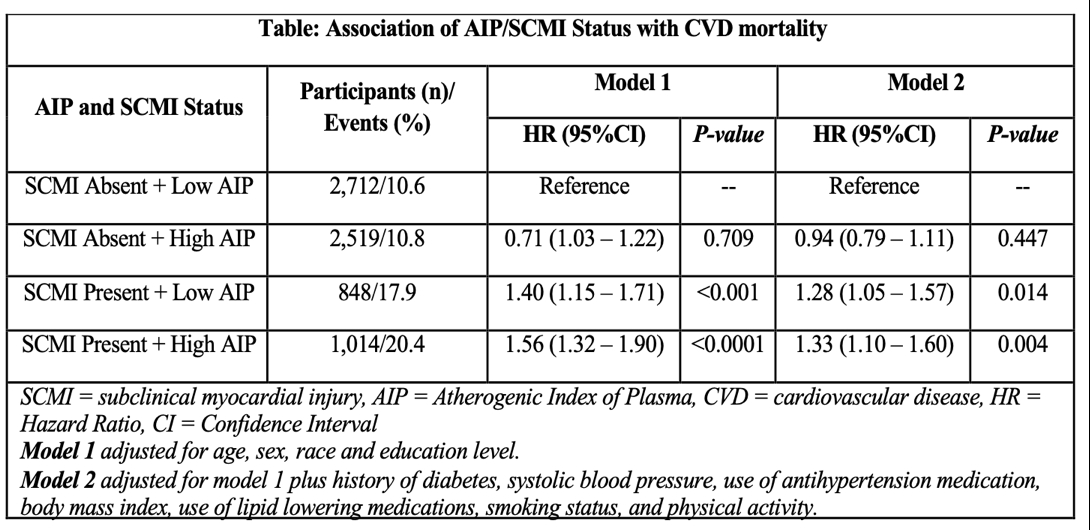Final ID: P2080
Interrelations between Atherogenic Index of Plasma, Subclinical Myocardial Injury, and Cardiovascular Mortality in the General Population
Abstract Body: Background: The Atherogenic Index of Plasma (AIP), a novel biomarker of lipid metabolism, is linked to adverse cardiovascular disease (CVD) outcomes. Subclinical myocardial injury (SCMI) may precede clinically evident CVD. We examined the association between AIP and SCMI, and their combined impact on CVD mortality in the general population.
Methods: We analyzed 7,093 participants without CVD from the Third National Health and Nutrition Examination Survey. AIP was calculated as the logarithmic ratio of triglycerides to HDL cholesterol. Participants were stratified into low or high AIP groups based on the median AIP value (0.958). SCMI was defined by a Cardiac Infarction/Injury Score (CIIS) ≥10 from 12-lead electrocardiograms. Four groups were created based on AIP and SCMI status. CVD mortality data were obtained from the National Death Index. Multivariable logistic regression models assessed the cross-sectional association between AIP and SCMI, while Cox proportional hazards models examined the relationship between different AIP/SCMI groups and CVD mortality.
Results: At baseline, 1,861 participants had SCMI, and 3,533 had high AIP. In the cross-sectional analysis, adjusted for socio-demographics and CVD risk factors, high AIP was significantly associated with increased odds of SCMI [OR (95% CI): 1.20 (1.07–1.35)]. Compared to participants with low AIP and absent SCMI, those with SCMI, irrespective of AIP level, had a significantly higher risk of CVD mortality in multivariable Cox proportional hazard models. However, high AIP without SCMI was not associated with CVD mortality (AIP/SCMI interaction p-value = 0.477) (Table).
Conclusions: In a CVD-free general population, high AIP was associated with an increased risk of SCMI. While SCMI was linked to a higher risk of CVD mortality regardless of AIP levels, high AIP was only associated with CVD mortality when SCMI was present. These findings suggest that the reported adverse outcomes linked to high AIP may be driven by the development of SCMI.
Methods: We analyzed 7,093 participants without CVD from the Third National Health and Nutrition Examination Survey. AIP was calculated as the logarithmic ratio of triglycerides to HDL cholesterol. Participants were stratified into low or high AIP groups based on the median AIP value (0.958). SCMI was defined by a Cardiac Infarction/Injury Score (CIIS) ≥10 from 12-lead electrocardiograms. Four groups were created based on AIP and SCMI status. CVD mortality data were obtained from the National Death Index. Multivariable logistic regression models assessed the cross-sectional association between AIP and SCMI, while Cox proportional hazards models examined the relationship between different AIP/SCMI groups and CVD mortality.
Results: At baseline, 1,861 participants had SCMI, and 3,533 had high AIP. In the cross-sectional analysis, adjusted for socio-demographics and CVD risk factors, high AIP was significantly associated with increased odds of SCMI [OR (95% CI): 1.20 (1.07–1.35)]. Compared to participants with low AIP and absent SCMI, those with SCMI, irrespective of AIP level, had a significantly higher risk of CVD mortality in multivariable Cox proportional hazard models. However, high AIP without SCMI was not associated with CVD mortality (AIP/SCMI interaction p-value = 0.477) (Table).
Conclusions: In a CVD-free general population, high AIP was associated with an increased risk of SCMI. While SCMI was linked to a higher risk of CVD mortality regardless of AIP levels, high AIP was only associated with CVD mortality when SCMI was present. These findings suggest that the reported adverse outcomes linked to high AIP may be driven by the development of SCMI.
More abstracts on this topic:
Admission Cell-free DNA Predicts Cardiogenic Shock Progression and In-Hospital Mortality
Park Ashley, Kong Hyesik, Andargie Temesgen, Jang Moon, Solomon Michael, Brusca Samuel, Barnett Christopher, Obrien Connor, Agbor-enoh Sean
A large-scale multi-view deep learning-based assessment of left ventricular ejection fraction in echocardiographyJing Linyuan, Metser Gil, Mawson Thomas, Tat Emily, Jiang Nona, Duffy Eamon, Hahn Rebecca, Homma Shunichi, Haggerty Christopher, Poterucha Timothy, Elias Pierre, Long Aaron, Vanmaanen David, Rocha Daniel, Hartzel Dustin, Kelsey Christopher, Ruhl Jeffrey, Beecy Ashley, Elnabawi Youssef

